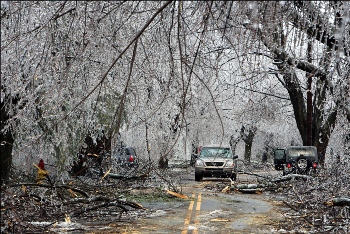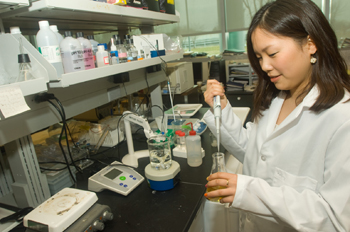Preparing for the Challenges of a Large-Scale Emergency
School of Public Health, NYSDOH host discussion on emergency preparedness for vulnerable populations, August 5th at 1 p.m.
 |
Felled branches lay in the road after the December 2008 ice storm. UAlbany's School of Public Health hosts a forum Aug. 5 to help health officials understand the needs of vulnerable populations during large-scale emergencies. (Photo John Tlumacki, Boston Globe) |
Weather-related emergencies are far from a rare occurrence in the Northeastern United States. One need only recall the December 2008 ice storm that affected much of New York and Massachusetts. But while power outages and slippery roads can cause headaches for many people, health officials have a different set of concerns when the skies grow dim. Whether it is a blizzard that hinders normal means of travel to medical appointments and the grocery store, or a pandemic that could stress hospitals and clinics, significant care must be taken to ensure the well-being of vulnerable populations.
On Wednesday, August 5, UAlbany�s School of Public Health will host a community forum designed to help emergency preparedness officials understand the special needs of three vulnerable populations -- elderly adults, residents of isolated rural areas, and persons with physical disabilities -- during a large-scale emergency. Sponsored by the School�s Center for Public Health Preparedness and the New York State Department of Health Office of Emergency Preparedness, representatives from organizations serving these populations will meet at 1 p.m. on the University�s East Campus in East Greenbush to discuss how people in these groups would access essential services in the event of a widespread public emergency such as a blizzard or pandemic flu.
"The recent H1N1 influenza outbreak makes this event especially timely," said School of Public Health Dean Philip C. Nasca. "Most health agencies have the sense that this experience was just a glimpse of what might have been, and so they are girding for the worst-case scenario that may lie ahead."
Participants include representatives 18 agencies throughout New York, including senior services organizations, local hospitals, and regional associations such as the Adirondack Rural Health Network, the Center for Disability Services and Senior Services of Albany.
 |
Planning for emergencies, such as developing vaccines for diseases such as the H1N1 influenza strain, form a critical component of addessing the needs of vulnerable populations. (Photo Mark Schmidt) |
"As New York State plans for the possible resurgence in novel H1N1 influenza this fall and winter, it is important to continue to look at how we will address the needs of our most vulnerable citizens," said State Health Commissioner Richard F. Daines, M.D. "We can never be too prepared. This is an opportunity to consider safeguards to further protect our state's most vulnerable populations."
"Emergency plans need to be more focused than a 'one-size-fits all' approach," said Edward Waltz, director of the CDC-funded Center for Public Health Preparedness. "We are providing a forum so that key informants, such as service providers, can provide insights into the needs of the populations they serve. Our findings will be disseminated to appropriate agencies to help them shape their plans to meet these specific needs during the next widespread emergency event, whether that is the next wave of influenza, a massive ice storm, or whatever nature throws at us."
The Center for Public Health Preparedness (CPHP) is part of a national network of public health preparedness centers funded since 2002 by theCenters for Disease Control and Prevention (CDC). The CPHP provides highly relevant emergency preparedness training, resources, and assistance to public health professionals and their community response partners by delivering programs in the most appropriate method for the subject and audience� including, but not limited to live and online courses and workshops. The Center also assists its partners with technical assistance, planning and implementing drills and exercises, and evaluation support.
![]() For more news, subscribe to UAlbany's RSS headline feeds
For more news, subscribe to UAlbany's RSS headline feeds


